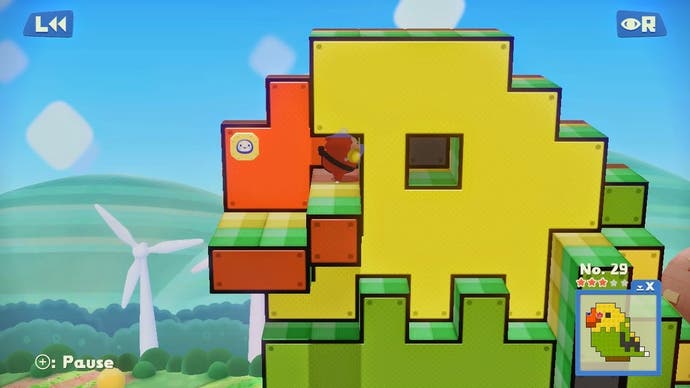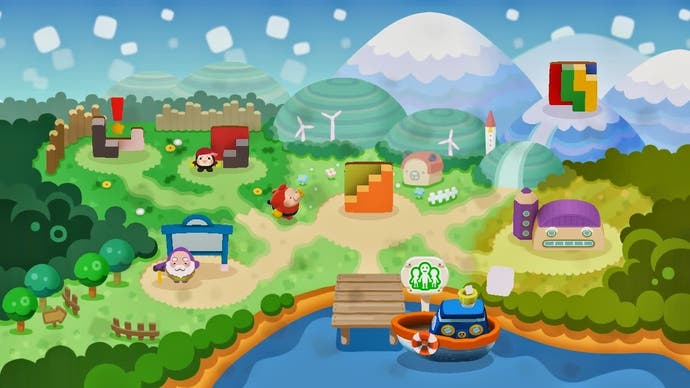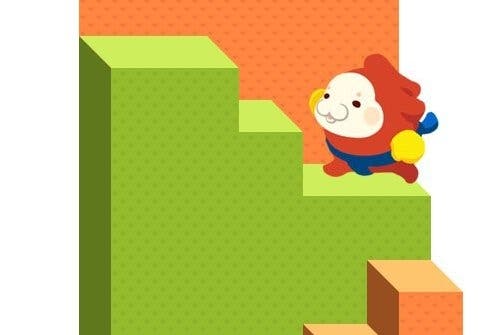Pullblox World review
Slide away.
"World" has pretty specific connotations in Nintendospeak. Ever since being used to mark the moment that Super Mario Bros. graduated from the NES to the SNES and became the all-encompassing platforming genius we know today, it's become a signifier not only of a series moving to new hardware, but of that series cementing its evolution and preparing for the future. "This sequel," it says, "is a new beginning."
Fans of 3DS puzzle gem Pullblox and its sequel Fallblox - known as Pushmo and Crashmo in North America - would be forgiven for expecting a similarly confident stamp to be placed on the series' first Wii U entry. The first game introduced the simple but ingenious concept of pulling and pushing different parts of increasingly elaborate constructions in order to create climbable platforms. As rotund, bum-faced hero Mallo, you journey from one puzzle to the next, rescuing children who have been trapped inside these colourful Rubik-esque health and safety hazards. Yes, this is still a game where crushed children with eerily flattened faces play a crucial role.
Fallblox took the idea even further, adding physics to the mix along with the ability to move blocks left and right as well as pulling and pushing them on the Y axis, and also found room for a slew of clever new gadgets and features. The stage would seem to be set for a super-sequel that combined and developed aspects of both titles - a game that would justify the name Pullblox World.

Pullblox World has the name and the new hardware, but it's more of an uncertain step forwards than a bold leap. More Pullbox would be a better title, since that's essentially what you get. The wild innovations of Fallblox are simply abandoned and what new gadgets Pullblox World offers - blocks with timers, gadgets that move all blocks of the same colour at the same time - are instead sidelined in the new Mysterious Pullblox area. They're genuinely game-changing, but often don't get the room needed to fully develop. There's experimentation here, but it's hemmed in by a disappointing conservatism in the overall package.
"More of the same" isn't too brutal a criticism, admittedly, since Pullblox remains one of the loveliest and most fiendishly designed puzzle games of recent years, and also one of the most invisible. One of the disadvantages of Nintendo's piecemeal online policy is that its eShop titles have none of the visibility that games on PlayStation Network and Xbox Live Arcade benefit from. It's entirely possible that you've not only not played the previous 3DS games, but have no idea they exist.
In that case, you're in for a treat. Aptly named developer Intelligent Systems has come up with 250 new puzzles that run the gamut from pleasingly simple to mind-bogglingly complex. For all its cute flourishes this is still a ferociously demanding game, arguably one of the few remaining puzzle titles that still dares to truly challenge you. Balancing that out is the same casual approach to progress that manifested in the first games. You can skip any puzzle you want, without penalty, and can always hop over to the training area of the map where simplified practice puzzles help you to get your head around the concepts needed to beat the later levels.
In moving to the Wii U, the series benefits from the shift to HD telly-sized graphics. It's not an insanely detailed game, but the bold colours and chunky lines really pop on a bigger screen. The 3D effect, obviously, has gone and that's a shame, since in a game where moving platforms into and out of the screen is the meat of the gameplay, the 3DS' party trick was genuinely useful. Instead, here you're able to use the GamePad's right stick to revolve the camera. Click it in and the camera sticks in place, a feature that is indispensable as the puzzles grow from small, basic contraptions to enormous conceptual pieces.
Returning from the 3DS games is the Pullblox Studio, where you can design your own levels. This is a natural fit for the Gamepad's sizeable screen, and you can once again generate QR codes to share your creations. Simpler creations are even backwards compatible and can be scanned into the 3DS games. More interesting is the World Fair, where user-designed levels can be uploaded for other Wii U players. This integrates seamlessly with the console's Miiverse functions, making it one area where it feels like the series has been genuinely moved forwards by the move to a larger, more connected console.
Yet there are plenty of other areas that have been left untouched. There's no multiplayer, for example, even though the prospect of co-operative Pullblox puzzles where you must work together to ascend each tower seems like an obvious addition. Nor does the game make particularly good use of the GamePad outside of the Studio elements. You can play it entirely on the pad, if you want, but there's potential in the interplay between Wii remotes and GamePad, the TV and the smaller screen, that is entirely ignored.

In the end, it's hard to be too down on Pullblox World. It's a puzzle game and its puzzles are undeniably brilliant. Whether you're an existing fan of this fledgling series or are coming to it for the first time, there's more than enough pleasure to be found in this suite of expertly crafted brainteasers and their beautifully paced escalation. On that basis, you'd have to be some sort of monster not to recommend it.
But Pullblox World is also a sequel and a fairly timid one at that. If you've been following the series and hoped for a similar leap in design as the one between Pullblox and Fallblox, your enjoyment will be tinged with mild disappointment. There's clearly more that can be done with this concept on this hardware and it's a shame to see such a promising series tread water so early in its life. If the next entry takes a similarly cautious approach, it'll be time to worry. For now, enjoy what is still one of the best and most undervalued puzzle games around.


